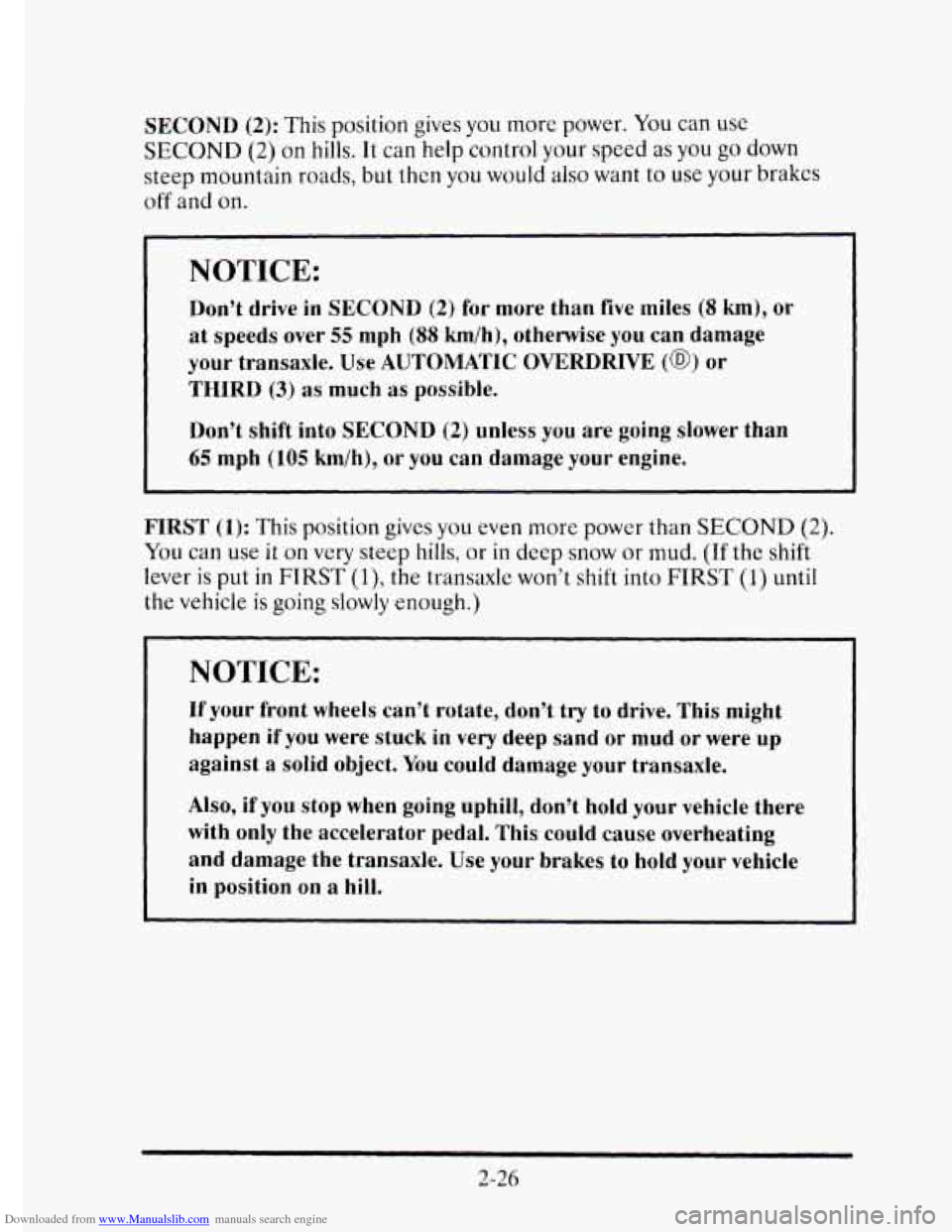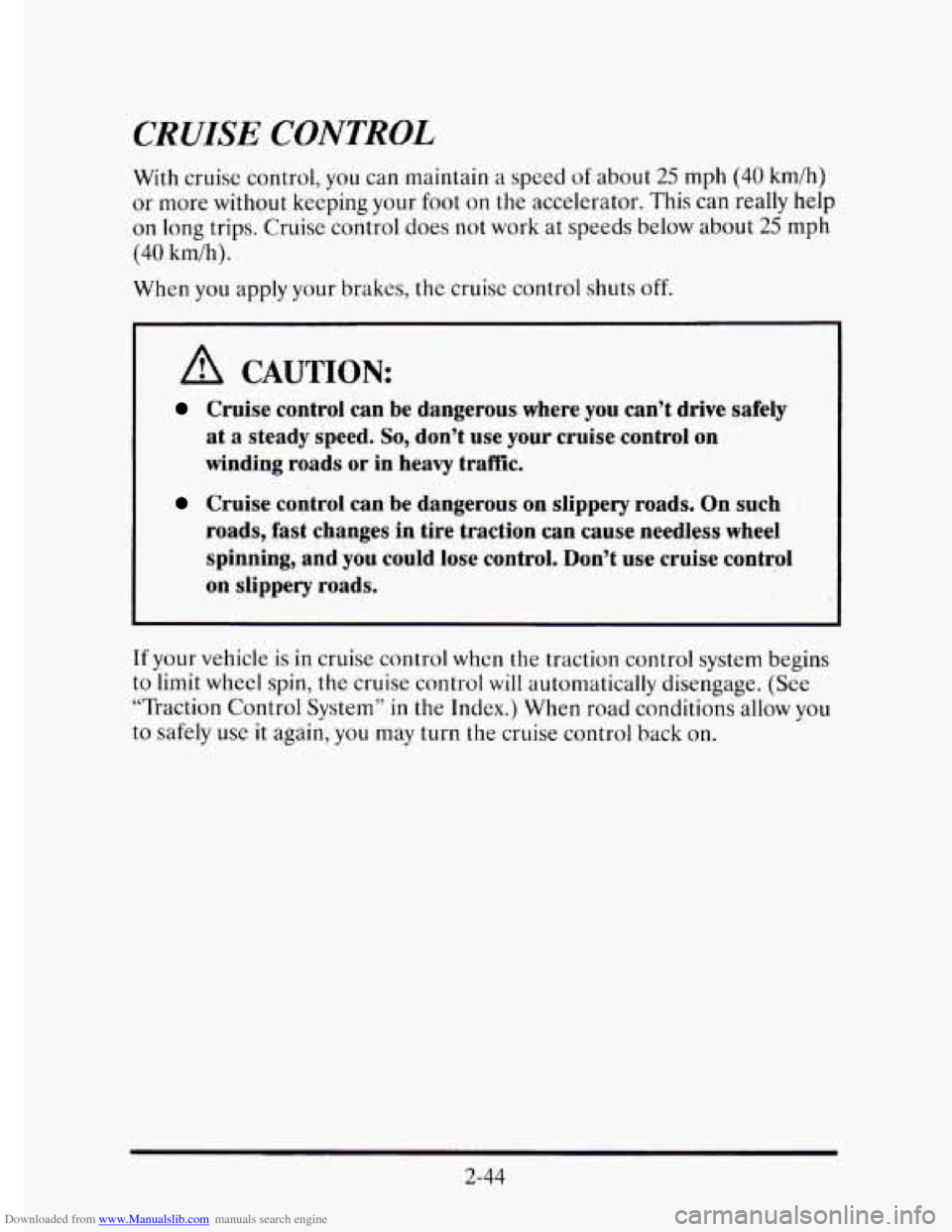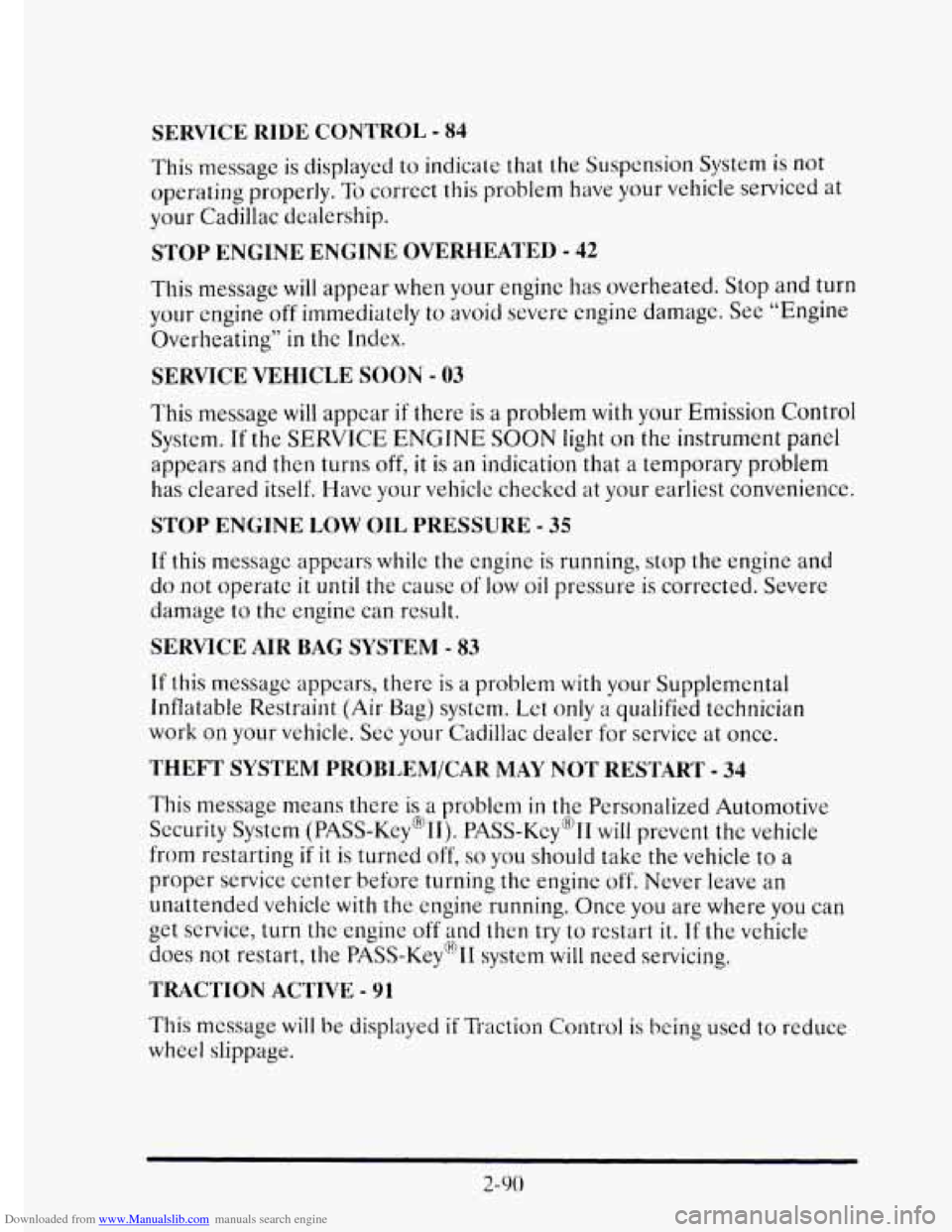Page 95 of 395

Downloaded from www.Manualslib.com manuals search engine Ensure the shift lever is fully in PARK (P) range before starting the
engine. Your Cadillac has
a brake-transaxle shift interlock. You have to
fully apply your regular brakes befure you can shift from PARK (P) when
when the ignition key is
in the RUN position. If you cannot shift out of
PARK (P), ease pressure on the shift lever -- push the shift lever all the
way into PARK (P) and release the shift lever button
on the floor shift
console models as you maintain brake application. Then move the shift
lever into the gear you wish. (Press the shift lever button before moving
the shift lever
on floor shift console models.) See “Shifting Out of
PARK (P)” in this section.
REVERSE (R): Use this gear to back up.
NOTICE:
Shifting to REVERSE (R) while your vehicle is moving forward
could damage
your transaxle. Shift to REVERSE (R) only after
your vehicle
has stopped.
Also use this gear to rock your vehicle back and forth to get out of snow,
ice or sand without damaging your transaxle. See “If You’re Stuck in
Sand,
Mud, Ice or Snow” in the Index for additional information.
NEUTRAL, (N): In this position, your engine doesn’t connect with the
wheels.
To restart when you’re already moving, use NEUTRAL (N) only.
Also, use NEUTRAL (N) when your vehicle is being towed.
2-24
1
1
a
Page 97 of 395

Downloaded from www.Manualslib.com manuals search engine SECOND (2): This position gives you more power. You can use
SECOND (2) on hills. It can help control your speed as you go down
steep mountain roads, but then you would also want to use your brakes
off and on.
NOTICE:
Don’t drive in SECOND (2) for more than five miles (8 km), or
at speeds over 55 mph (88 km/h), otherwise you can damage
your transaxle.
Use AUTOMATIC OVERDRIVE (@) or
THIRD (3) as much as possible.
Don’t shift into
SECOND (2) unless you are going siower man
65 mph (105 km/h), or you can damage your engine.
FIRST
(1): This position gives you even more power than SECOND (2).
You can use it on very steep hills, or in deep snow or mud. (If the shift
lever is put
in FIRST (I), the transaxle won’t shift into FIRST (1) until
the vehicle is going slowly enough.)
NOTICE:
If your front wheels can’t rotate, don’t try to drive. This might
happen
if you were stuck in very deep sand or mud or were up
against a solid object. You could damage your transaxle.
Also,
if you stop when going uphill, don’t hold your vehicle there
with only the accelerator pedal. This could cause overheating
and damage the transaxle. Use your brakes to
hold your vehicle
in position on a
hill.
2-26
Page 108 of 395
Downloaded from www.Manualslib.com manuals search engine HORN
To sound the horn just press the center of the steering wheel.
TILT WHEEL
A tilt steering wheel allows you to adjust the steering wheel before you
drive.
You can also raise
it to the highest level to give your legs more room when
you exit and enter the vehicle.
c
, :.
To tilt the wheel hold
the steering wheel
and
pull the lever. Move
the steering wheel to
a
comfortable level, then
release the lever to
lock the wheel
in place.
2-37
Page 115 of 395

Downloaded from www.Manualslib.com manuals search engine CRUISE CONTROL
With cruise control, you can maintain a speed of about 25 rnph (40 km/h)
or more without keeping your foot on the accelerator. This can really help
on long trips. Cruise control does
not work at speeds below about 25 rnph
(40 km/h).
When
you apply your brakes, the cruise control shuts off.
A CAUTION:
Cruise control can be dangerous where you can’t drive safely
at a steady speed. So, don’t use your cruise control on
winding roads or
in heavy traf‘fic.
Cruise control can be dangerous on slippery roads. On such
roads, fast changes in tire traction can cause needless wheel
spinning, and you could lose control. Don’t use cruise control
on slippery roads.
If your vehicle is in cruise control when the traction control system begins
to limit wheel spin, the cruise control will automatically disengage. (See
“Traction Control System”
in the Index.) When road conditions allow you
to safely use it again, you may turn the cruise control back on.
2-44
Page 148 of 395

Downloaded from www.Manualslib.com manuals search engine Anti-Lock Brake System Warning Light
ANTI-
LOCK (@)
With the anti-lock brake system, this light will come on when you start
your engine and may stay
on for several seconds. That’s normal. If the
light doesn’t come on, have it fixed
so it will be ready to warn you if there
is a problem.
If the light stays on, turn the ignition off. Or, if the light comes on when
you’re driving, stop as soon as possible and turn the ignition
off. Then
start the engine again
to reset the system. If the light still stays on, or
comes on again while you’re driving, your Cadillac needs service. If the
regular brake system warning light isn’t
on, you still have brakes, but you
don’t have anti-lock brakes. If the regular brake system warning light is
also on,
you don’t have anti-lock brakes and there’s a problem with your
regular brakes. See “Brake System Warning Light” earlier
in this part.
Traction Disabled Message
If this message is displayed, there’s a problem with your traction control
system and your vehicle needs service. When this message
is displayed,
the system
will not limit wheel spin. Adjust your driving accordingly.
Traction Control System Active Message
When your traction control system is limiting wheel spin, the TRACTION
ACTIVE message will be displayed. Slippery road conditions may exist if
this message is displayed, so adjust your driving accordingly. This message
will stay
on for a few seconds after the traction control system stops
limiting wheel spin.
2-77
Page 161 of 395

Downloaded from www.Manualslib.com manuals search engine SERVICE RIDE CONTROL - 84
This message is displayed to indicate that the Suspension System is not
operating properly. To correct this problem have
your vehicle serviced at
your Cadillac dealership.
STOP ENGINE ENGINE OVERHEATED - 42
This message will appear when your engine has overheated. Stop and turn
your engine
off immediately to avoid severe engine damage. See “Engine
Overheating”
in the Index.
SERVICE VEHICLE SOON - 03
This message
will appear if there is a problem with your Emission Control
System. If the SERVJCE ENGINE SOON light on the instrument panel
appears and then turns off, it is an indication that a temporary problem
has cleared itself. I-Iavc your vehiclc checked at your earliest convenience.
STOP ENGINE LOW OIL PRESSURE - 35
If this message appears while the cngine is running, stop the engine and
do not operate it until the cause of low oil pressure is corrected. Severe
damage
to the engine can result.
SERVICE AIR BAG SYSTEM - 83
If this message appears, there is a problem with your Supplemental
Inflatable Restraint (Air
Bag) systcm. Let only a qualified technician
work
on your vehicle. See yo& Cadillac dealer for service at once.
THEFT SYSTEM PROBLEM/CAK MAY NOT RESTART - 34
This message means there is a problem in the Personalized Automotive
Security System (PASS-Key@II). PASS-Key@)II
will prevent the vehicle
from restarting
if it is turned off, so you should take the vehicle to a
proper service center before turning the engine off. Never leave an
unattended vehicle
with the engine running. Once you are where you can
get service, turn the engine off
and then tIy to restart it. If the vehicle
does not restart, the PASS-Key(’I1 system
will need servicing.
TRACTION ACTIVE - 91
This mcssage will be displayed if Traction Control is being used to reduce
wheel slippage.
2-90
Page 194 of 395
Downloaded from www.Manualslib.com manuals search engine Here’s how anti-lock works. Let’s say the road is wet. You’re driving
safely. Suddenly an animal jumps out
in front of you.
You slam on the brakes. Here’s what happens with ABS.
A computer senses that wheels are slowing down. If one of the wheels is
about to stop rolling, the computer will separately work the brakes at each
front wheel and at the rear wheels.
The anti-lock system can change the brake pressure faster than any driver
could. The computer
is programmed to make the most of available tire
and road conditions.
4-7
Page 195 of 395
Downloaded from www.Manualslib.com manuals search engine You can steer around the obstacle while braking hard.
As you brake, your computer keeps receiving updates on wheel speed and
controls braking pressure accordingly.
Remember: Anti-lock doesn’t change
the time you need to get your foot
up to the brake pedal. If you get too close to the vehicle in front of you,
you won’t have time to apply your brakes
if that vehicle suddenly slows or
stops. Always leave enough room up ahcad to stop, even though you have
anti-lock brakes.
To Use Anti-Lock
Don’t pump the brakes. Just hold the brake pedal down and let anti-lock
work for you.
You may hear the anti-lock pump or motor operate, and
feel
the brake pedal pulsate, but this is normal.
4-8